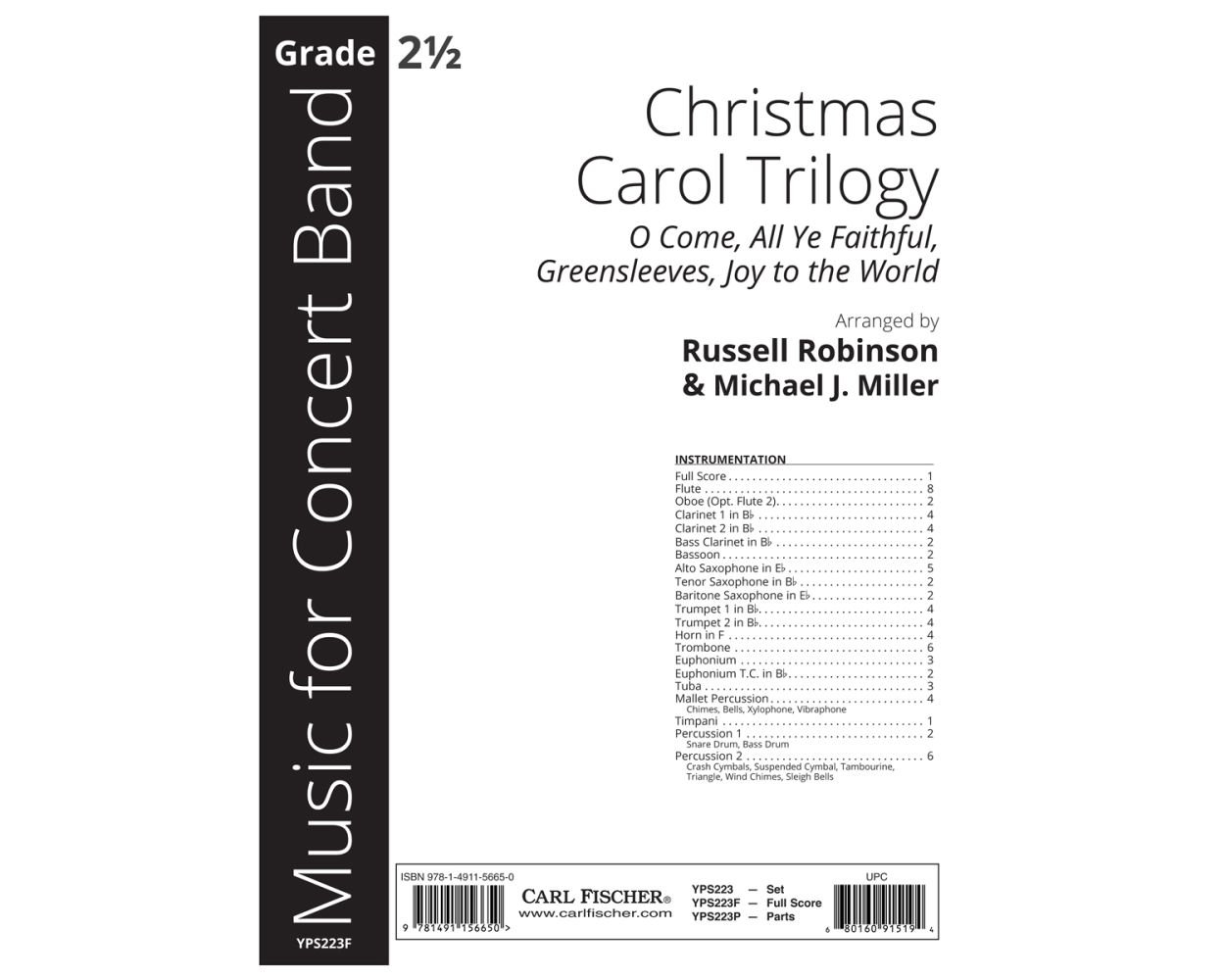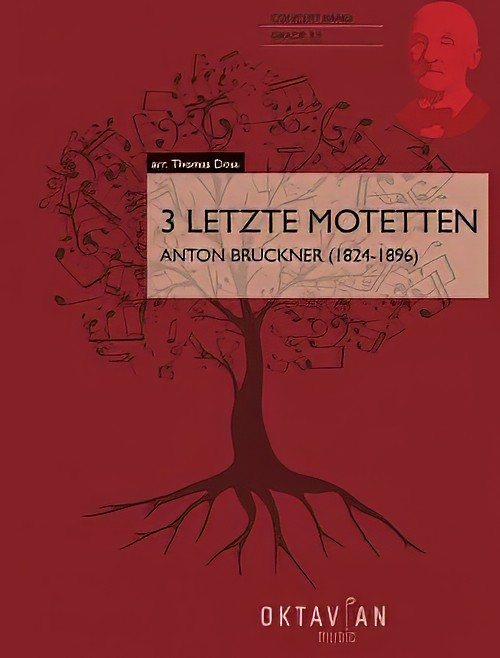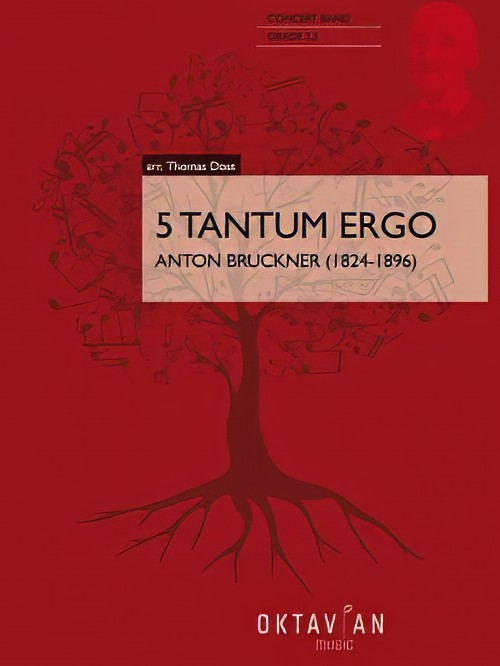Results
-
 £205.30
£205.30Lena - Kjell Karlsen
"Lena" was one of the finalists in the Norwegian edition of Eurovision Song Contest in 1969 where it ended 2nd in the final.This arrangement for vocal soloist with Concert Band is a typical feelgood-song suitable for any entertainment concert. The vocal part will best suit a male soloist.
Estimated dispatch 7-14 working days
-
£39.95
Our Father - Score and Parts - Gordon Camsey
Program NotesThere have been numerous vocal settings of The Lord's Prayer over the years, and several of them have found their way into various areas of instrumental repertoire.This beautifully crafted yet simple arrangement by Gordon Camsey has found its way from its original choral version to the medium of wind band, where the melodic lines will offer real scope to express and exploit the widely varied tone colours that are available. Although brief in duration, it would provide an effectively restful moment of contrast in a concert programme, and could also be used effectively as prelude music at a church or ceremonial occasion.
Estimated dispatch 7-14 working days
-
£7.95
Our Father - Score only - Gordon Camsey
Program NotesThere have been numerous vocal settings of The Lord's Prayer over the years, and several of them have found their way into various areas of instrumental repertoire.This beautifully crafted yet simple arrangement by Gordon Camsey has found its way from its original choral version to the medium of wind band, where the melodic lines will offer real scope to express and exploit the widely varied tone colours that are available. Although brief in duration, it would provide an effectively restful moment of contrast in a concert programme, and could also be used effectively as prelude music at a church or ceremonial occasion.
Estimated dispatch 7-14 working days
-
£13.95
Roman Trilogy
1Royal Windsor PortraitsMartin EllerbyRichard Moore (Vocal) with Royal Northern College of Music Wind Orchestra13.292Turquoise WaterTom MossMay Crick (Alto Saxophone) with Royal Northern College of Music Wind Orchestra7.143Old World OvertureNigel ClarkeRoyal Northern College of Music Wind Orchestra5.354-6Trombone ConcertoRob WiffinBrett Baker (Trombone) with Royal Northern College of Music Wind Orchestra I. Movement I 7.01 II. Movement II 6.53 III. Movement III 4.287Storm SurgeNigel ClarkeBenjamin K. Lewis (Narrator) with Royal Northern College of Music Wind Orchestra12.468Still WatersRob WiffinIsabelle Orford (Oboe) wiith Royal Northern College of Music Wind Orchestra4.289-11Roman TrilogyMartin EllerbyRoyal Northern College of Music Wind Orchestra I. Colosseo di Roma 4.32 II. Cappelia Sistina 4.11 III. Fontana di Trevi 2.32
Estimated dispatch 7-14 working days
-
£13.95
The Very Best of Festival of Music Volume 3
1In the MoodRazaf & GarlandThe Royal Air Force Squadronaires3.302Moonlight SerenadeMillerThe Royal Air Force Squadronaires4.153Don't Sit Under the Apple TreeStept, Tobias & BrownThe Royal Air Force Squadronaires2.444StardustParish & CarmichaelRoy Castle & Sgt. Geoffrey Lawrence (Trumpets) with The Royal Air Force Squadronaires2.415American PatrolGrayThe Royal Air Force Squadronaires3.406Blue SkiesBerlinThe Royal Air Force Squadronaires2.477A Foggy DayGershwinThe Royal Air Force Squadronaires2.218A Nightingale Sang in Berkeley SquareMaschwitzPeter Appleyard (Vibraphone) with The Royal Air Force Squadronaires4.569Tuxedo JunctionHawkins, Johnson, Dash & FayneThe Royal Air Force Squadronaires3.1710FeverCooley & DavenportThe Royal Air Force Squadronaires3.5711Marching Thro'McParland & StirlingThe Royal Air Force Squadronaires3.2912String of PearlsGrayThe Royal Air Force Squadronaires3.1513After You've GoneCreamer & LaytonPeter Appleyard (Vibraphone) with The Royal Air Force Squadronaires4.1214Birth of the Bluesde Sylva, Brown & HendersonRoy Castle (Vocal & Trumpet) with The Royal Air Force Squadronaires3.1615SkylinerBarnetThe Royal Air Force Squadronaires3.1216Cheek to CheekBerlinThe Royal Air Force Squadronaires4.1417Owed to Mr ChopinDorseyFlight Lieutenant Stuart Stirling (Piano) with The Royal Air Force Squadronaires3.3718Pennsylvania 65000Sigman & GrayThe Royal Air Force Squadronaires3.3719Travelogue: The Big Countryarr. StirlingThe Massed Bands of TheRoyal Air Force and Squadronaires11.06
Estimated dispatch 7-14 working days
-
 £53.00
£53.00Christmas Carol Trilogy - Traditional Christmas Songs
Christmas Carol Trilogy includes the three beloved favorites, "O Come All Ye Faithful," "Greensleeves," and "Joy to the World." This band arrangement can be played alongside Robinson's vocal arrangements of the same name but is also wonderful as a stand-alone piece. Perfect for your seasonal concert needs, all who listen will be embraced by the warmth and joy of the holiday season.
Estimated dispatch 12-14 working days
-
 £72.00
£72.00On Parade - Edwin Franko Goldman
Edwin Franko Goldman's energetic composition On Parade is both programmatic and descriptive of parades from yesteryear, complete with bugle, fife (piccolo), and drum strains. In addition, a joyful vocal refrain was included in the 1934 edition of the march with lyrics by Goldman. Edward Lisk's meticulous, modern edition brings this wonderful new march to the attention of a whole new generation of band musicians.
Estimated dispatch 12-14 working days
-
 £72.99
£72.99For Good (from Wicked) (Concert Band with opt. Choir & Strings - Score and Parts) - Schwartz, Stephen - Brown, Michael
This gorgeous arrangement of the tender ballad about the love shared between best friends from the hit musical, Wicked, will be the perfect showcase of your young band's tone, phrasing and musicianship. Masterfully scored to be either a standalone arrangement or as an accompaniment to the vocal arrangement by Mac Huff. Add strings to the band arrangement to create a lush, full orchestra accompaniment.
Estimated dispatch 7-14 working days
-
 £123.20
£123.203 Letzte Motetten (Concert Band - Score and Parts) - Bruckner, Anton - Doss, Thomas
Anton Bruckner (b. 4.9.1824, Ansfelden, d. 11.10.1896, Vienna) didn't have it easy. Throughout his life, the Austrian composer was plagued by self-doubt. Anton Bruckner came from a simple, rural background. After the death of his father, he was accepted as a choirboy at the monastery of Sankt Florian in 1837. After several years as a school assistant and his own organ and piano studies, he first worked as organist in St. Florian, then from 1855 as cathedral organist in Linz. Introduced to music theory and instrumentation by Simon Sechter and Otto Kitzler, he discovered Richard Wagner as an artistic role model, whom he admired throughout his life and also visited several times in Bayreuth. In 1868 Anton Bruckner became professor of basso continuo, counterpoint and organ at the Vienna Conservatory; ten years later court organist; and in 1891 finally honorary doctor of the University of Vienna. He was considered an important organ virtuoso of his era, but had to wait a long time for recognition as a composer. It was not until Symphony No.7 in E major, composed between 1881 and 1883, with the famous Adagio written under the effects of Wagner's death, that he achieved the recognition he had hoped for, even if he was reluctant to accept it given his inclination towards scepticism and self-criticism. Anton Bruckner was a loner who did not want to follow a particular school or doctrine. He composed numerous sacred vocal works, such as his three masses, the Missa Solemnis in B flat minor (1854), the Te Deum (1881-84) and numerous motets. As a symphonic composer, he wrote a total of nine symphonies and many symphonic studies from 1863 onwards, tending to revise completed versions several times over. Bruckner's orchestral works were long considered unplayable, but in fact were merely exceptionally bold for the tonal language of their time, uniting traditions from Beethoven through Wagner to folk music, on the threshold between late Romanticism and Modernism. Anton Bruckner composed about 40 motets during his lifetime, the earliest a setting of Pange lingua around 1835, and the last, Vexilla regis, in 1892. Thomas Doss has compiled some of these motets in this volume for symphonic wind orchestra. These motets show many characteristics of personal expression, especially Bruckner's colourful harmony in the earlier works, which is in places aligned with Franz Schubert (changes between major and minor; and movements in thirds). Later works are characterised by many components which, in addition to the expanded stature of the movements, include above all a sense of the instrumentation as an outward phenomenon and the harmony as a compositional feature that works more internally. Some aspects of Bruckner's work are the result of his long period of study, which familiarised him not only with the tradition of his craft, but also gave him insights into the "modernity" of his time in such composers as Wagner, Liszt and Berlioz. From this developed his personal standpoint, which always pursues the connection between the old and the new.Duration: 14.00
Estimated dispatch 7-14 working days
-
 £95.99
£95.995 Tantum Ergo (Concert Band - Score and Parts) - Bruckner, Anton - Doss, Thomas
Anton Bruckner (b. 4.9.1824, Ansfelden, d. 11.10.1896, Vienna) didn't have it easy. Throughout his life, the Austrian composer was plagued by self-doubt. Anton Bruckner came from a simple, rural background. After the death of his father, he was accepted as a choirboy at the monastery of Sankt Florian in 1837. After several years as a school assistant and his own organ and piano studies, he first worked as organist in St. Florian, then from 1855 as cathedral organist in Linz. Introduced to music theory and instrumentation by Simon Sechter and Otto Kitzler, he discovered Richard Wagner as an artistic role model, whom he admired throughout his life and also visited several times in Bayreuth. In 1868 Anton Bruckner became professor of basso continuo, counterpoint and organ at the Vienna Conservatory; ten years later court organist; and in 1891 finally honorary doctor of the University of Vienna. He was considered an important organ virtuoso of his era, but had to wait a long time for recognition as a composer. It was not until Symphony No.7 in E major, composed between 1881 and 1883, with the famous Adagio written under the effects of Wagner's death, that he achieved the recognition he had hoped for, even if he was reluctant to accept it given his inclination towards scepticism and self-criticism. Anton Bruckner was a loner who did not want to follow a particular school or doctrine. He composed numerous sacred vocal works, such as his three masses, the Missa Solemnis in B flat minor (1854), the Te Deum (1881-84) and numerous motets. As a symphonic composer, he wrote a total of nine symphonies and many symphonic studies from 1863 onwards, tending to revise completed versions several times over. Bruckner's orchestral works were long considered unplayable, but in fact were merely exceptionally bold for the tonal language of their time, uniting traditions from Beethoven through Wagner to folk music, on the threshold between late Romanticism and Modernism. Hymns for four-part mixed choir a cappella (1846, St. Florian) No. 1 in E flat major (WAB 41/3): Quite Slow No. 2 in C major (WAB 41/4): Andante No. 3 in B flat major (WAB 41/1): Slow No. 4 in A flat major (WAB 41/2): Slow Hymn for five-part (SSATB) mixed choir and organ No. 5 in D major: Solemnly They are simple works, completely subordinate to their liturgical use, which nevertheless already show numerous characteristics of personal expression. These small pieces were able to stand up to the harsh scrutiny of the mature master: in 1888, Bruckner subjected them to a revision in which he made only minor corrections.Duration: 11.00
Estimated dispatch 7-14 working days
